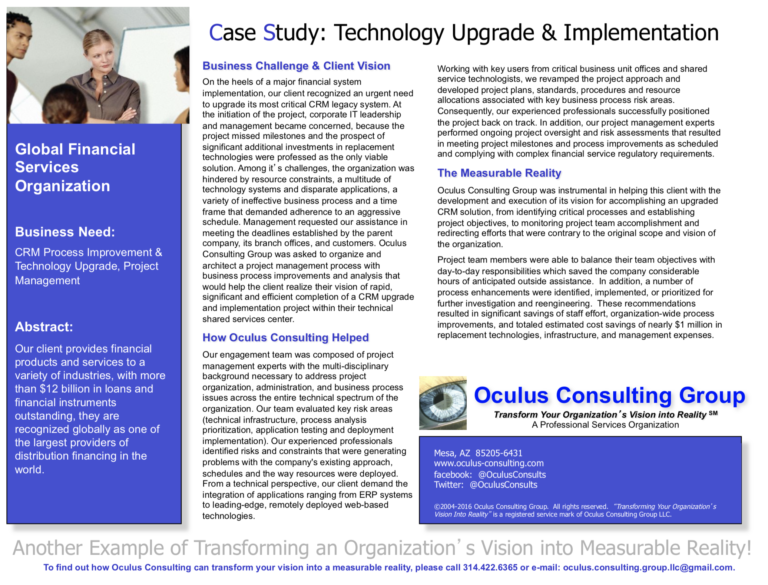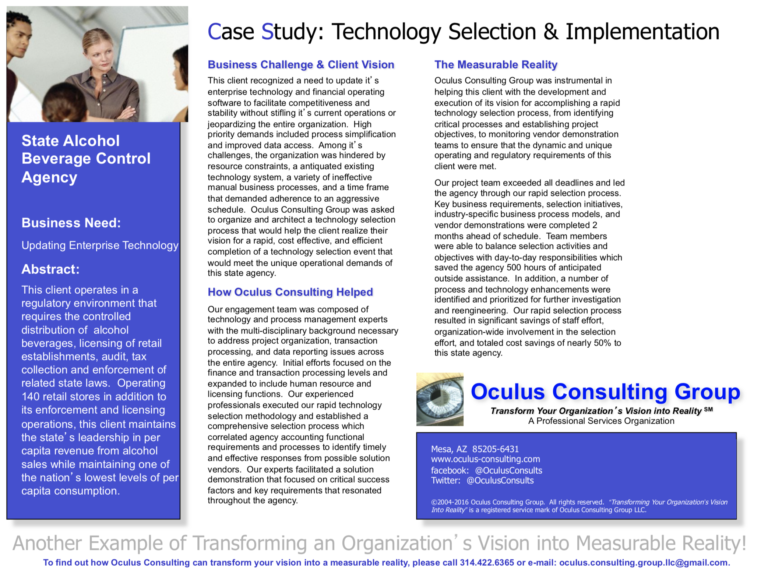Enterprise-Wide Systems and Competitive Strategy
Diligent executives across the organization must ask themselves and their key resources a series of questions to enable an accurate determination of how an enterprise-wide solution will ultimately affect their competitive advantage.

By Oculus Consulting Group LLC
Since the Y2K implementation frenzy of the late 1990s, it is not a stretch or new idea to say that information systems have an impact on business strategy, organizational strategy, or business transformation efforts.
Today’s social media-centric world has only emphasized the need for understanding how enterprise-wide technology impacts your organization’s competitive advantage. Does the implementation of an enterprise-wide system really yield a competitive advantage, or is the process simply a series of speed bumps along the operational efficiency speedway creating significant obstacles? More importantly, how does the selection and implementation of an enterprise-wide system change your strategy and create a competitive advantage when every organization in your industry is adopting the same enterprise system? Or worse yet, has the implementation of an enterprise-wide system become an introductory cost of doing business – one that simply creates parity between organizations when everyone else in the industry is using the same core technology? What are the critical considerations in which these enterprise-wide systems might affect business and competitive strategy? In this blog post, Oculus Consulting Group LLC shares some opinions and possible insights into answering these questions.
Financial Strategy Impact
Financial strategies may be the first to notice an impact from your enterprise-wide system decisions. Even with the cost of application service providers or hosted solutions, the transition costs associated with process reengineering and data migration can be significant. For solutions with embedded infrastructure in the organization, the costs can rise substantially. The immediate result is often a realization that cost savings will be delayed, and that they may not be as sizeable as initially anticipated. Spending tens or hundreds of millions of dollars on the enterprise solution will at some point require payback, which will require cost reductions elsewhere in the organization or eventual infusion of the costs of the technology into the organization’s products and services. Another aspect of the financial strategy that may feel an immediate impact on the solution decision will be major changes in key business processes. The cost trade-off is constantly being assessed against such high-profile metrics as reduced inventories and labor costs, better agility to deal with customers and suppliers, and better management decision making through information access. At Oculus Consulting Group LLC, we understand that enhancements to your organization’s bottom line are an essential ingredient of any enterprise solution decision. Our demonstrated experience in helping organizations achieve that bottom line result has been documented publicly.
“Enterprise-wide solutions can have a huge impact on an organization’s operational strategies as a result of their impact on key business processes.”
Operational Strategy Impact
The most obvious areas that are impacted by the enterprise solution decision will involve the organization’s operational strategies. Enterprise-wide solutions can have a huge impact on an organization’s operational strategies as a result of their impact on key business processes. The implementation graveyard is littered with organizations that made enterprise-wide solution decisions and then missed key product deliveries, failed to pay employees, or lost critical customer interactions. It is possible that some organizational strategies will only be achieved with the assistance of an enterprise-wide solution. Techniques such as just-in-time, order-to-cash, enroll-to-pay, among others typically involve a global or enterprise-wide approach involving suppliers, manufacturing plants, or customer relationship systems across the enterprise. Simply put, it is difficult to achieve the cross-functional coordination necessary for these processes to ensure success without the integrated infrastructure and systems that are prevalent at the source of the process.





While organizations continually tout the benefits and efficiencies of enterprise-wide technology solutions, there are issues involved in trying to achieve competitive advantage from the implementation and use of these systems. Diligent executives across the organization must ask themselves and their key resources a series of questions to enable an accurate determination of how an enterprise-wide solution will ultimately affect their competitive advantage. A sampling of these questions could include:
⇒ What are the current sources of our organization’s competitive advantage? How will this enterprise-wide technology solution affect our current capabilities in these areas?
⇒ Will the enterprise-wide technology bring about new strategic capabilities that may be useful in the future? Are we simply addressing current inefficiencies or issues that will require a revisit of technology in the future?
⇒ How will the costs of this technology affect the cost position of my products and services? If my competitive advantage is built surrounding a cost advantage, will I still maintain that cost advantage after the implementation of this technology?
⇒ What are the other firms in my industry implementing with regard to this technology? How likely is it to affect their strengths and weaknesses? If my primary competitors are all moving to this technology, what will the competitive dynamics for our industry look like after everyone is up on the same enterprise-wide solution? Most importantly, which of my competitors is likely to be dramatically successful with their implementation, and who may be in a position of struggling to survive the shift?
⇒ If other firms operating in my industry are also implementing enterprise-wide technology, am I going to need to connect to them, and how? How will my current connections be enhanced or possibly damaged by this technology?
⇒ Are there particular aspects of the business where it would be damaging to my organization to have a commodity or industry-standard information and process system?
⇒ Will this project distract me from doing what is really most important to my business? If I am required to devote considerable human resources or employ an army of external consultants to accomplish this implementation how will I accomplish the day-to-day activities that still need to be performed? Can our organization afford this diversion?
⇒ How will this enterprise technology interface to my key platforms and systems, and can we afford any degradation in performance? How will this implementation leverage our social media presence and key communication strategies?
Enterprise Systems & Industry Influence
If the entire industry is moving to a particular enterprise-wide solution, the potential basis for your organization’s competitive advantage will shift. It is no longer viable to just have similar technology that will be your organization’s differentiator, but your implementation must be better than your competitors or be accomplished a way that better fits your organization than their implementation fits them. Carefully considering whether to implement the enterprise technology and which specific attributes of it should be adopted, can prevent your implementation from becoming a move to simply maintain parity with your competitors.
In order to know where your competitive advantages will come from in the post-implementation world, it is essential to know where your advantages are derived today. Understanding your organization’s particular competitive value disciplines today will help ensure that you are maintaining those value disciplines in the post-implementation arena. If your current advantages are based upon operational excellence, then your processes and technology may be a good candidate for being enhanced by the enterprise-wide solution.
If you decide that your competitive advantages are derived primarily from other technology applications, especially via custom-developed solutions, you will need to intimately investigate the costs of developing them or creating the interfaces to connect them to the new enterprise-wide solution. Because these costs will be significant and have the greatest probability of escalating out of control, your organization must follow through on ensuring the technology actually delivers the benefits and advantages initially proposed for consideration.
Simply securing and implementing new integrated enterprise-wide solutions across your organization is not enough to achieve the required cost-based advantage that your financial strategies will demand. Your organization will need a substantial amount of organization discipline, performance measurement programs with meaningful corresponding metrics, cost-oriented emphasis on enhancements and integrations, and management teams who are focused incessantly on cost both before as well as after the implementation.
Competitive Advantage?
Your organization’s competitive advantages are not derived from systems, but from doing something better than your competitors. Simply selecting and implementing a technology solution won’t bring you that advantage. Making sure your organization knows what that “something” is, and how your organization is going to be doing “it” better with the technology in a post-implementation world is key to maintaining your competitive advantage.
At Oculus Consulting Group, our expertise and assistance have helped organizations transform their vision for effective enterprise-wide solution implementation and performance measurement into a measurable reality of improved competitive advantage.
To learn how you can secure our services and assistance, please contact us.
© 2018-2021 Oculus Consulting Group LLC
Oculus Consulting Group LLC and “Transform Your Organization’s Vision into a Measurable Reality are registered service marks of Oculus Consulting Group LLC.
